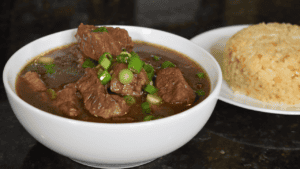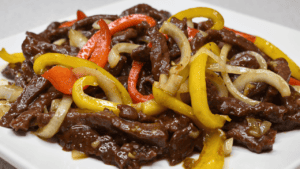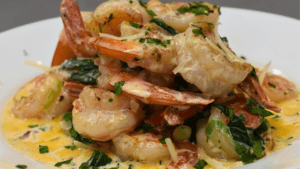Sinigang na Danggit (Rabbit Fish in Tamarind Soup)
Sinigang na danggit is a popular Filipino dish made of fish, vegetables, and a tangy broth. The term “sinigang” means to stew in a sour broth. Traditionally flavored with tamarind, it can also use calamansi, guava, or kamias for its signature sour taste.
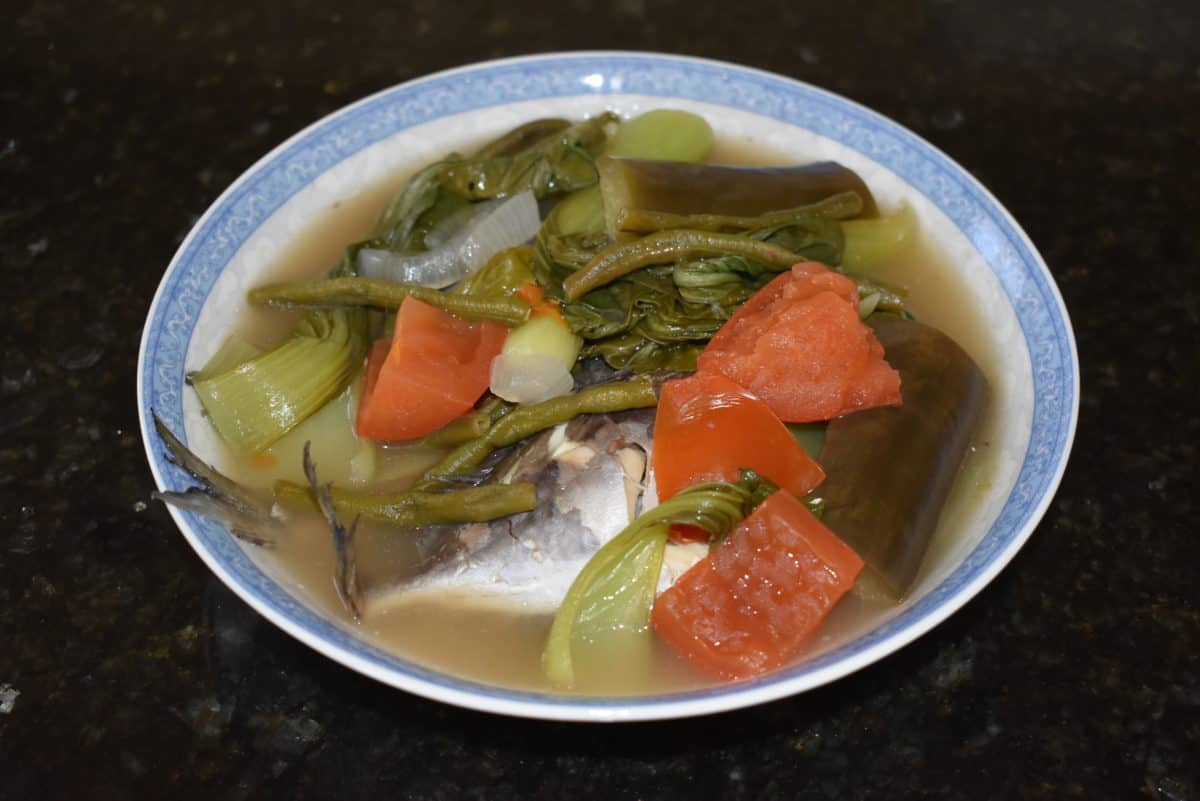
Discover the Tangy Delight of Sinigang na Danggit Recipe
Introduction to Sinigang na Danggit A Filipino Sour Soup Dish
Sinigang na Danggit is more than just a dish; it’s a cultural experience that captures the essence of Filipino cuisine. Known for its unique sour flavor, this soup is a staple in many Filipino households. The origins of Sinigang can be traced back to the early days of Philippine history, where the abundance of local ingredients like tamarind and native vegetables made it a practical and popular choice. Over time, it has evolved, but its core essence remains—a comforting bowl of sour soup packed with fresh ingredients.
The popularity of Sinigang na Danggit among home cooks and seafood lovers is no surprise. This dish combines the ocean’s bounty with the comforting warmth of a well-seasoned broth. It’s a favorite not just for its taste but also for its versatility and ease of preparation. Home cooks love it for its simplicity and the way it brings families together around the dining table. For seafood enthusiasts, the inclusion of danggit or rabbit fish offers a delightful twist on the classic sinigang, enhancing its appeal.
In this blog post, we’ll explore the ins and outs of making Sinigang na Danggit. From gathering the right ingredients to cooking it to perfection, we’ll guide you every step of the way. Whether you’re a seasoned home cook or someone just starting to explore Filipino cuisine, this guide will help you bring this beloved dish to life in your own kitchen.
Ingredients Needed for Cooking Sinigang na Danggit
Creating Sinigang na Danggit starts with gathering the freshest ingredients. The main component, danggit or rabbit fish, should be cleaned and prepared ahead of time. To complement the fish, you’ll need ripe tomatoes, a staple in many Filipino kitchens, which add a subtle sweetness to the sour broth. Eggplant slices, chopped ginger, and long beans are key vegetables that provide texture and flavor to the dish. Don’t forget the baby bok choy, which adds a touch of green freshness to the soup.
For those who may not have access to traditional ingredients, substitutions are possible. Instead of fresh tamarind, a packet of sinigang mix can be used for convenience, offering the signature sour taste without compromising flavor. If rabbit fish isn’t available, other white fish varieties like tilapia or mackerel work just as well, keeping the dish deliciously authentic.
Sourcing these ingredients is often easier than expected, especially in areas with vibrant Filipino communities or well-stocked Asian grocery stores. Here, you’ll likely find everything you need to create an authentic Sinigang na Danggit. These stores often carry a wide selection of fresh produce and specialty items like sinigang mix, ensuring you have all the elements necessary for this flavorful endeavor.
Step-by-Step Cooking Instructions
Cooking Sinigang na Danggit involves a series of simple yet crucial steps that ensure the best results. Begin by boiling six cups of water in a pot over medium heat. It’s essential to bring the water to a vigorous bubble within about five minutes. This boiling step is the foundation for integrating flavors that make this soup so special.
Once the water is boiling, add the aromatic ingredients—ginger, chopped onion, and tomatoes—into the pot. Along with these, incorporate your preferred sinigang mix. Stir well to ensure the flavors blend harmoniously, letting them cook together for another five minutes. This creates the rich broth that will enhance the entire dish.
Next, introduce the vegetables, starting with the sliced eggplant and long beans. Allow them to cook until tender, approximately five minutes. Finally, gently add the cleaned danggit and baby bok choy to the pot, letting everything simmer gently for a final five minutes. This step is crucial for ensuring the fish remains tender and the bok choy retains its crispness. Serve hot, paired with steamed rice, and enjoy the harmonious blend of textures and flavors.
Variations and Customizations
One of the joys of cooking Sinigang na Danggit is its adaptability. Different regions in the Philippines have their own takes on this classic dish, each bringing something unique to the table. In some areas, for instance, kamias or bilimbi is used as a souring agent instead of tamarind, offering a different kind of tanginess that is equally delightful.
Personalizing Sinigang na Danggit to suit your taste is part of the fun. If you prefer a spicier kick, consider adding a few slices of chili pepper into the broth. Alternatively, for a milder taste, adjust the quantity of the sinigang mix you use. Many home cooks also experiment by adding other vegetables like radishes or spinach, enhancing both the nutritional content and flavor profile of the soup.
The versatility of Sinigang na Danggit is what makes it such a beloved dish. Feel free to explore and incorporate your favorite ingredients, crafting a version that reflects your personal taste and preference. Remember, there are no strict rules, just guidelines that allow you to create something deliciously unique.
Health Benefits of the Dish
Sinigang na Danggit is not only a flavorful delight but also a nutritious addition to a balanced diet. The primary ingredient, danggit or rabbit fish, is rich in protein and omega-3 fatty acids, essential for heart health and overall well-being. Coupled with fresh vegetables like bok choy and tomatoes, the dish provides a variety of vitamins and minerals beneficial to your health.
The nutritional value extends beyond the main components. Ingredients like ginger are known for their anti-inflammatory properties, while eggplants offer fiber that aids digestion. The soup’s unique combination of sour and savory elements stimulates appetite and provides a comforting meal that’s light yet satisfying.
Incorporating Sinigang na Danggit into your meal plans can contribute to a balanced diet, particularly if you’re mindful of portion sizes and pair it with healthy sides like brown rice or quinoa. It’s a dish that not only tantalizes your taste buds but also supports your health.
Serving Suggestions and Pairings
While Sinigang na Danggit stands out on its own, pairing it with the right accompaniments can elevate your dining experience. Traditionally, it’s served with a generous portion of steamed white rice, which absorbs the rich flavors of the broth beautifully. However, feel free to experiment with different grains, like jasmine or basmati rice, for a subtle variation in taste.
For those looking to enhance their meal further, consider serving the soup with a side of salted eggs or fried shrimp, both of which complement the sour notes perfectly. A simple salad with a vinegar-based dressing can also provide a refreshing counterbalance to the richness of the broth.
In terms of beverages, a tall glass of iced tea or calamansi juice pairs wonderfully with Sinigang na Danggit, providing a sweet contrast to the savory dish. For those who enjoy wine, a crisp white like Sauvignon Blanc can complement the flavors without overpowering them.
Conclusion
Sinigang na Danggit is more than just a dish; it’s an invitation to explore the rich flavors and culinary traditions of the Philippines. With its balance of sour and savory, it’s no wonder this soup holds a special place in the hearts of many. By following this guide, you can bring a taste of the Philippines into your own kitchen, enjoying both the process and the delicious results.
We encourage you to try making Sinigang na Danggit at home and experience the joy it brings. Share your cooking adventures with us, and stay tuned for more exciting recipes and tips to enrich your culinary repertoire. Whether you’re a seasoned cook or a beginner, there’s always something new to discover in the world of Filipino cuisine.
Frequently Asked Questions About Sinigang na Danggit
Is sinigang fish healthy?
Absolutely! Sinigang na Danggit, made with rabbit fish, is a healthy dish rich in protein and omega-3 fatty acids.
Is it okay to cook sinigang in a rice cooker?
While traditional methods are recommended, a rice cooker can be used for convenience if adjusted properly.
What makes sinigang good?
Its unique balance of sour and savory flavors, coupled with fresh ingredients, makes sinigang a comforting and delicious dish.
Is sinigang supposed to be sour?
Yes, the sourness is a defining characteristic, usually achieved with tamarind, calamansi, or other souring agents.
Is sinigang mix healthy or unhealthy?
Sinigang mix is generally safe in moderation, but fresh ingredients are always preferable for health-conscious cooks.
What is the English of sinigang?
Sinigang is commonly referred to as “sour soup” in English.
How do you remove bitterness from sinigang?
Adding a bit of sugar or more vegetables can balance out any bitterness in the soup.
What is the best souring agent for sinigang?
Tamarind is the most traditional and popular choice, but calamansi and kamias are also used.
How do you fix too sour sinigang?
To mellow the sourness, you can add more water or a pinch of sugar.
What is the characteristic of sinigang?
Sinigang is known for its tangy, savory broth filled with meats or seafood and various vegetables.
Why do Filipinos love sinigang?
The comforting, homey flavors and versatility make it a beloved part of Filipino culture.
What are some interesting facts about sinigang?
Sinigang was once named the best rated vegetable soup in TasteAtlas, reflecting its global appeal.
What goes well with sinigang?
Rice, salted eggs, and iced tea are classic accompaniments that enhance the dining experience.
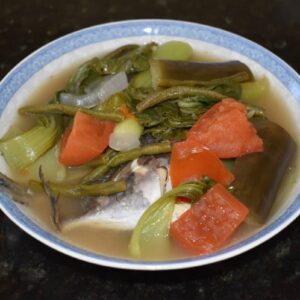
Sinigang na Danggit (Rabbit Fish in Tamarind Soup)
Ingredients
- 2 lbs rabbit fish cleaned
- 2 medium tomatoes chopped
- 1 medium eggplant sliced
- 1 medium ginger chopped
- ½ lb long beans cut into pieces
- 1 lb baby bokchoy
- 1 packet sinigang mix
- 1 medium onion chopped
- 6 cups water
Instructions
- Boil a pot of water on medium heat for about 5 minutes until it bubbles vigorously.
- Add aromatic ginger, onion, tomatoes, and your preferred sinigang mix. Stir well and allow the flavors to blend for 5 minutes.
- Incorporate the sliced long beans and eggplant, cooking them for another 5 minutes until tender.
- Gently introduce the fish and fresh bok choy, letting everything simmer gently for a final 5 minutes to perfection.
- Serve this flavorful dish hot with a generous portion of rice, and enjoy the comforting warmth and taste.
